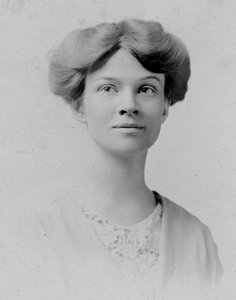Katharine Martha Houghton Hepburn facts for kids
Quick facts for kids
Katharine Martha Houghton Hepburn
|
|
|---|---|
 |
|
| Born |
Katharine Martha Houghton
February 2, 1878 |
| Died | March 17, 1951 (aged 73) West Hartford, Connecticut, USA
|
| Education | Radcliffe College |
| Alma mater | Bryn Mawr College |
| Occupation | Activist |
| Known for | Mother and namesake of Katharine Hepburn |
| Spouse(s) |
Thomas Norval Hepburn
(m. 1904) |
| Children | 6, including Katharine Hepburn |
| Parent(s) | Caroline Garlinghouse Alfred Augustus Houghton |
| Relatives | See Houghton family |
Katharine Martha Houghton Hepburn (born February 2, 1878 – died March 17, 1951) was an American activist who worked for social change. She was a strong leader in the suffrage movement in the United States. This movement fought for women's right to vote.
Katharine Hepburn was the president of the Connecticut Woman Suffrage Association. Later, she joined the National Woman's Party. She was also the mother of the famous actress Katharine Hepburn.
Contents
Early Life and Education
Katharine Martha Houghton was born on February 2, 1878, in Buffalo, New York. Her family and friends called her "Kit." Her parents were Caroline and Alfred Augustus Houghton. Her family was known for the Corning Incorporated glass company.
Katharine had two younger sisters, Edith and Marion. Her parents were progressive thinkers. This meant they believed in new ideas, especially about women's education.
A Promise Kept
When Katharine was young, her father passed away. Soon after, her mother became very ill. Before she died, her mother stressed how important it was for her daughters to go to college.
Katharine's uncle, Amory Houghton Jr., thought young women should go to "finishing school." This was a place to learn social skills, not academic subjects. But Katharine remembered her mother's wish.
Despite her family's objections, Katharine kept her promise. She graduated from Bryn Mawr College in Pennsylvania in 1899. She earned a degree in history and political science. She also studied chemistry and physics. Later, she briefly attended Radcliffe College. Her sisters, Edith and Marion, also graduated from Bryn Mawr.
Working for Change: Women's Rights
Katharine Hepburn became very interested in the suffrage movement. This movement worked to get women the right to vote. In 1909, she helped start the Hartford Equal Franchise League.
This group later joined the Connecticut Woman's Suffrage Association (CWSA). It became part of a bigger national group called the National American Woman Suffrage Association.
Meeting the President
As president of the CWSA, Katharine Hepburn represented Connecticut. In 1913, she was part of a group that met with President Woodrow Wilson. They wanted to know his thoughts on women getting the right to vote.
Earlier that year, Hepburn hosted a famous British suffragette, Emmeline Pankhurst. Pankhurst was visiting Hartford to give speeches about women's voting rights.
Joining the National Woman's Party
In 1917, Katharine Hepburn left her role as CWSA president. She felt the group was too old-fashioned. She then joined Alice Paul and the National Woman's Party. This group was known for being more active and determined.
Alice Paul later said that Hepburn was "the unquestioned leader of the suffragists . . . in Connecticut." Hepburn was chosen to lead the legislative committee for the National Executive Committee of the National Woman's Party.
After the Nineteenth Amendment was passed in 1920, women finally had the right to vote. The Democratic Party asked Hepburn to run for the U.S. Senate. However, she decided not to run for office.
Katharine's Beliefs
Katharine Hepburn believed in socialism. This is a political and economic idea where the community or government owns and controls the means of production and distribution of goods. She also enjoyed talking about politics and current events. She liked Russian history, especially the Bolshevik Revolution. She also enjoyed reading plays by William Shakespeare and Bernard Shaw.
She wasn't a big fan of movies. She preferred live theater instead. Her daughter Katharine, the actress, once joked that it was "curious that Fate gave her a movie-queen daughter."
Personal Life and Family
Around 1903, Katharine Houghton met Thomas Norval Hepburn. He was a medical student at Johns Hopkins School of Medicine. They got married on June 6, 1904.
After they married, the Hepburns moved to Hartford, Connecticut. Dr. Hepburn became a urologist, a doctor who specializes in the urinary system. He worked at Hartford Hospital for about 50 years. The family lived in West Hartford, Connecticut, and also had a summer home in Old Saybrook, Connecticut.
Katharine and Thomas had six children:
- Thomas Houghton "Tom" Hepburn (1905–1921)
- Katharine Houghton Hepburn (1907–2003), a famous actress who won four Academy Awards
- Richard Houghton "Dick" Hepburn (1911–2000), a writer
- Dr. Robert Houghton "Bob" Hepburn (1913–2007), a urologist
- Marion Houghton Hepburn Grant (1918–1986), a historian and activist
- Margaret Houghton "Peg" Hepburn Perry (1920–2006), a librarian and farmer
In the early 1930s, Katharine Hepburn taught her two youngest daughters, Marion and Margaret, at home. Marion said her mother was a "natural-born teacher" who loved sharing new books and ideas with her children.
Katharine Martha Houghton Hepburn passed away suddenly in March 1951, at the age of 73.
Legacy and Recognition
Katharine Hepburn once said, "Don't regret your daily chores. They are what keep you from going insane."
In 1988, the Katharine Houghton Hepburn Fund was created. This fund helps provide emergency money for reproductive rights.
In 1994, Hepburn was honored by being added to the Connecticut Women's Hall of Fame. She was recognized for her work as a "Reformer."
In 2006, her college, Bryn Mawr, opened the Katharine Houghton Hepburn Center. This center honors both Katharine Martha Houghton Hepburn and her daughter, actress Katharine Hepburn. The center aims to inspire students to make a positive difference in the world.


